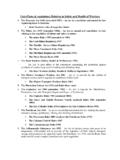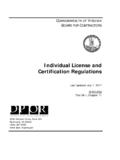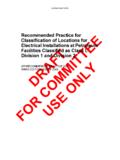Transcription of Texas Petroleum Refining and Chemical Products Cluster Rep…
1 State of TexasPetroleum Refining and Chemical ProductsCluster AssessmentAugust 20052 Table of ContentsExecutive Summary and Recommendations .. 3 Assessment Methodology and Recommendations .. 7 Summary of Findings .. 7 Cluster Mapping .. 17 The Competitive Landscape .. 18 Participant Acknowledgements .. 2331 Executive Summary and - Overview of the Texas Petrochemical and Refining Cluster Assessment ReportThe Texas Refining and Chemicals Industry Initiative Cluster is part of a recently launchedintensive effort to identify, bolster and exploit Texas competitive advantage in six technologyareas each considered to be key to the state future economic growth.
2 Texas is the nation sleading producer of oil and gas, refined Products , and chemicals. These industries are closelyinterrelated. For instance, the Texas chemicals industry is actually one of the largest consumersof Texas Petroleum Products both refined Products and natural gas. Chemical plants not onlyuse oil and gas Products as feedstock; they are substantial consumers of natural gas andelectricity to power their is home to 26 operating refineries (ironically, this is the same number of refineries it hadin the late 1930 s). Overall refinery capacity is approximately million barrels per day,accounting for over 26 percent of total US production, and approximately percent ofworldwide capacity.
3 The value of the refinery shipments in 2002 was about $ billion,representing percent of total US refinery shipments. Texas Gulf Coast refineries accountfor percent of the state s recent years, Texas refinery business has become far more complex. Environmental mandateshave required a tremendous amount of new investment to reduce refinery emissions and toproduce a variety of differing grades of lower-emitting fuels. Over the past decade, The Information Administration s Impact of Environmental Compliance Costs, 1995 2001,environmental mandates have accounted for from 10 to 50 percent of the industry s overallcapital investment is the nation s largest chemicals producer, manufacturing 14 percent of the nation s valueof Chemical output.
4 The Gulf Coast complex of Chemical plants and refineries is the largestpetrochemical complex in the world, home to over 200 Chemical plants. While the state s largestcomplex of Chemical plants is along the Gulf Coast, the industry itself is much more least 124 of Texas 254 counties have some amount of Chemical manufactured and petrochemicals are typically dependent on natural gas and other hydrocarbonderivative Products as both feedstocks and fuels. As natural gas prices have risen in recent years,margins for these commodity Products have been constrained. At the same time, internationalmarkets have drawn competitors to Asia, Europe, and Latin America.
5 Global pricingmechanisms now are at work for both crude oil and natural gas. This shift to a fundamentallyglobal market has had a tightening effect on North American supply, where competition is basedon economies in production, and processing is moving increasingly close to the same time that supply is constrained in Texas , the gas bubble is apparently drawing to aclose with the advent of facilities to handle large quantities of liquefied natural gas on the TexasGulf Coast. Increasing plant automation and product lifecycle management DCS applicationsare displacing workers but increasing product margins, if only slightly.
6 Co-locations ofsubsidiary production, and other supply chain partnerships, are creating new business RecommendationsThe Refining and Petrochemicals team, along with industry stakeholders across the state, met ina series of Cluster meetings and regional forums, to discuss sector-specific issues and the context of regional and state strengths and weaknesses in the industry, the groups wereasked to develop opportunities that would impact both the industry and the region. These resultswere then reported back to the Cluster team, were compared and prioritized. Three of thesepriorities, collaboration, workforce, and education, were identified as cross- Cluster addition, three other priorities were identified as CollaborationAdvanced Industry Collaborative Council Create an Advanced Industry Advisory Councilfunded by both state agencies and private sector companies across the industry spectrum(plant operators, vendors, contractors, etc) who will select and direct technology projects tobe undertaken, and select the resources (state, federal, private, local)
7 To be utilized in thepursuit of those Development and Expansion Opportunities Refining and chemicals companiesscreen expansion opportunities much like venture capital; state, regional and localgovernments must work in concert with industry to define what makes particular regionsattractive, and help plant managers promote Texas of Applicant Screening In some regions, plant managers perform screeningof potential candidates to build a pipeline of work-ready applicants. There is a strongopportunity for industry to develop a pilot project for regional screening in collaboration withthe Texas Workforce Commission and local workforce boards, in which the state andregional agencies could coordinate, administer, capture, and interview applicants, making theinformation available to all plant WorkforceSkills Training Breakthrough initiatives in the industry will require new skills.
8 Industrymust work with the Texas Workforce Commission and higher education community to definethe skills needed, the curricula to develop these skills, the timetable for deployment, and thescreening and certification criteria to develop this new workforce, including Federal EnergyRegulatory Commission Certification for Liquefied Natural Gas (LNG) ImageTexas graduates from community colleges and universities are not entering this industry;what hiring has been going on in the industry has become dependant on internationalgraduates and immigrants, but this pipeline has dried up since 9/11.
9 There must be a joint industry education program to educate students, especially inthe community colleges and universities, of the opportunities in this industry sector. Industry must work with the state, federal agencies, and Texas universities toestablish a process by which companies can sponsor foreign students education atTexas EducationIn all regions surveyed, there is a strong relationship between the industry and the localcommunity Demographic Study Perform a joint study with the Texas Chemical Council andthe higher education community in Texas to identify high performance programs in thedelivery of Work Ready programs for the Refining and chemicals industry.
10 Identify and propose replication of best practice programs within the communitycollege system to meet the emerging needs of the industry. Jointly monitor andmanage the development of these best practice programs across the state. Work with the higher education community in Texas to streamline regulatoryprocesses for the development and deployment of curricula leading to specializedcertification in areas identified as priority requirements by industry Just In Time Workforce Breakthrough technology initiatives will require new peoplewith new skills and competencies Partner industry with community colleges and technical schools to strengthen a workforce pipeline of technical skills and craft talent by strengthening curriculumdevelopment and establishing certification standards along emerging








